
Fucus vesiculosus, known by the common names bladder wrack, black tang, rockweed, ‘’’sea grapes’’’, bladder fucus, sea oak, cut weed, dyers fucus, red fucus and rock wrack, is a seaweed found on the coasts of the North Sea, the western Baltic Sea and the Atlantic and Pacific Oceans. It was the original source of iodine, discovered in 1811, and was used extensively to treat goitre, a swelling of the thyroid gland related to iodine deficiency.

Ascophyllum nodosum is a large, common cold water seaweed or brown alga (Phaeophyceae) in the family Fucaceae, being the only species in the genus Ascophyllum. It is a seaweed that only grows in the northern Atlantic Ocean, also known in localities as feamainn bhuí, rockweed, Norwegian kelp, knotted kelp, knotted wrack or egg wrack. It is common on the north-western coast of Europe including east Greenland and the north-eastern coast of North America, its range further south of these latitudes being limited by warmer ocean waters.

Arame, sea oak is a species of kelp, of the brown algae, best known for its use in Japanese cuisine.
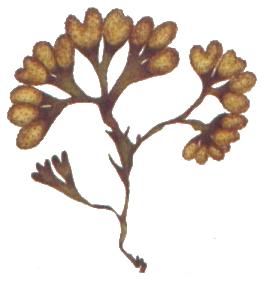
Fucus spiralis is a species of seaweed, a brown alga, living on the littoral shore of the Atlantic coasts of Europe and North America. It has the common names of spiral wrack and flat wrack.

Wrack is part of the common names of several species of seaweed in the family Fucaceae. It may also refer more generally to any seaweeds or seagrasses that wash up on beaches and may accumulate in the wrack zone.
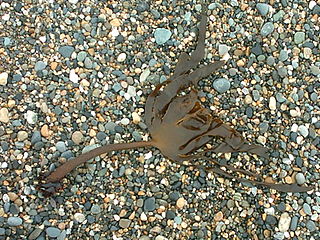
Ecklonia cava is an edible marine brown alga species found in the ocean off Japan and Korea. It is used as an herbal remedy in the form of an extract called Seanol, a polyphenolic extract, and Ventol, a phlorotannin-rich natural agent. Phlorotannins, such as fucodiphlorethol G, 7-phloro eckol, 6,6'-bieckol, eckol, 8,8'-bieckol, 8,4"'-dieckol and phlorofucofuroeckol A can be isolated from Ecklonia cava. Other components are common sterol derivatives.
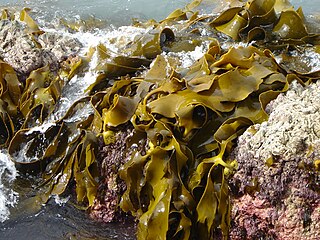
Phlorotannins are a type of tannins found in brown algae such as kelps and rockweeds or sargassacean species, and in a lower amount also in some red algae. Contrary to hydrolysable or condensed tannins, these compounds are oligomers of phloroglucinol (polyphloroglucinols). As they are called tannins, they have the ability to precipitate proteins. It has been noticed that some phlorotannins have the ability to oxidize and form covalent bonds with some proteins. In contrast, under similar experimental conditions three types of terrestrial tannins apparently did not form covalent complexes with proteins.
The epithallium or epithallus is the outer layer of a crustose coralline alga, which in some species is periodically shed to prevent organisms from attaching to and overgrowing the alga.
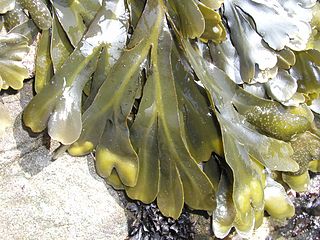
Fucus gardneri is a species of seaweed, a brown alga living on the littoral shore of the Pacific coasts of North America. It has the common names of rockweed and bladderwrack.

Phlorofucofuroeckol A is a phlorotannin isolated from brown algae species such as Eisenia bicyclis, Ecklonia cava, Ecklonia kurome or Ecklonia stolonifera.
Ecklonia stolonifera is a brown alga species in the genus Ecklonia found in the Sea of Japan. It is an edible species traditionally eaten in Japan.
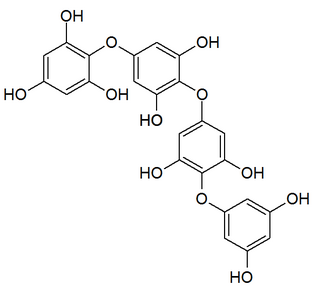
Tetraphlorethol C is a phlorethol-type phlorotannin found in the brown alga Ascophyllum nodosum. chemically, it is a tetramer of 1,2,3,5-Tetrahydroxybenzene

8,8'-Bieckol is an eckol-type phlorotannin found in the brown algae Ecklonia cava and Ecklonia kurome.

Eckstolonol is a phlorotannin found in the edible brown algae arame and turuarame.

Scytothamnus is a brown algae genus in the family Splachnidiaceae.

Scytothamnus australis is a brown alga species in the genus Scytothamnus found in New Zealand. It is a sulphated polysaccharide and the type species in the genus.

Analipus japonicus, or sea fir, is a brown alga species in the genus Analipus.

Cystophora retroflexa is a brown alga species in the genus Cystophora. It found is found off the coasts of New Zealand and Australia. It is the type species of the genus. Prefers more sheltered environments compared to other Cystophora species, often found in sheltered reefs from 0 to 12 m in depth.

Fucophlorethol A is a phlorotannin found in the brown alga Fucus vesiculosus.

Trifucol is a phlorotannin found in the brown algae Scytothamnus australis and Analipus japonicus.


















